More than 180 species of birds exist in the Valdes Peninsula either passing through on their chosen migratory route in flocks or alone or occupying a niche as a permanent resident. Many can be seen from Puerto Madryn or Puerto Piramides, while the observation of other species requires a more dedicated search in specific areas where they enjoy the solitude of this incredible geography, like “Bird Island” on the shores of Golfo San Jose. Here I have illustrated just 25 of these species.
Flamingo
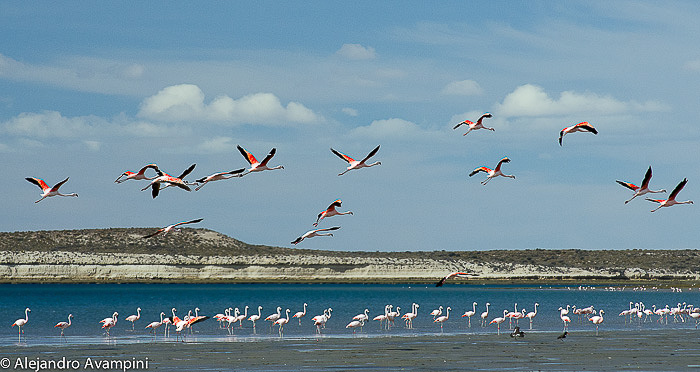 The Southern Flamingo is a large bird, most often seen in flocks. They can measure five feet, are easily identified by their pink colour on the outer feathers, their long neck, long legs and large wings. The legs have short toes, which are also webbed, helping the bird when swimming. Male flamingos are larger than females and this feature is the only visible difference between the sexes. The colour of their feathers are acquired by the food they eat, that’s why their offspring are born whitish and take on the intense pink colour from the small crustaceans, which form the major part of their diet. Flamingos are not resident in Valdes Peninsula area, however they nest in lakes in the Province of La Pampa. They are very wary birds and are easily disturbed by human presence. They can be very difficult to approach and photograph. The best way we have found to photograph them is to wait, camouflaged, at low tide. As the tide comes in, the birds will come to feed closer inshore. You must take great care not to alarm them or your opportunity will be lost. Photographing Flamingos requires a great deal of patience, as many of the professional photographers who live and work in the area will attest. Flamingos are not at all used to humans, living completely wild, and are, therefore, very elusive. Remember that Valdés Peninsula is an important area for wildlife to raise their young, and, as such is deserving of respect and minimal human impact. There are already 300,000 tourists visiting the area each year and the Peninsula is to some degree, affected by human greed. Please help to raise awareness of the need for respect for our wildlife by your own example.
The Southern Flamingo is a large bird, most often seen in flocks. They can measure five feet, are easily identified by their pink colour on the outer feathers, their long neck, long legs and large wings. The legs have short toes, which are also webbed, helping the bird when swimming. Male flamingos are larger than females and this feature is the only visible difference between the sexes. The colour of their feathers are acquired by the food they eat, that’s why their offspring are born whitish and take on the intense pink colour from the small crustaceans, which form the major part of their diet. Flamingos are not resident in Valdes Peninsula area, however they nest in lakes in the Province of La Pampa. They are very wary birds and are easily disturbed by human presence. They can be very difficult to approach and photograph. The best way we have found to photograph them is to wait, camouflaged, at low tide. As the tide comes in, the birds will come to feed closer inshore. You must take great care not to alarm them or your opportunity will be lost. Photographing Flamingos requires a great deal of patience, as many of the professional photographers who live and work in the area will attest. Flamingos are not at all used to humans, living completely wild, and are, therefore, very elusive. Remember that Valdés Peninsula is an important area for wildlife to raise their young, and, as such is deserving of respect and minimal human impact. There are already 300,000 tourists visiting the area each year and the Peninsula is to some degree, affected by human greed. Please help to raise awareness of the need for respect for our wildlife by your own example.
Reproduction
Flamingos are monogamous. and before pair-bonding, males and females gather in groups of up to 150 individuals, and perform the so-called “wedding march”, with their necks stretched upwards, moving head vigorously from side to side and up in one direction. The march is accompanied by a strong hoarse croak from the whole group. The birds then form pairs. Weeks later, nesting begins. Flamingo breeding colonies are characterized by a gathering of thousands of individuals. The nest is usually made of clay, in the shape of a truncated cone,with a depression in the centre. A single egg only is laid. After 30 days of incubation shared between both parents, the young are born with white plumage and straight beak, which takes the hooked form as they grow. At the age of a week or so, the young birds gather in creches, which can number up to a thousand individuals, guarded by several adult birds. After a few weeks, the appearance of the chicks changes. Plumage colour turns grey, with black legs, and the beak curves to resemble the parents’. The creches stay together until the age of three months, after which, the young are able to fend for themselves.
Choique
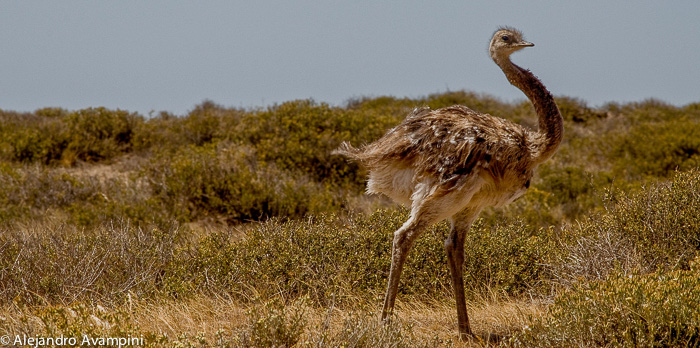 The Choique is a Patagonian symbol. Source of inspiration for stories and legends, the rhea is so present in folklore as in all the paths in Patagonia. It is a large , herbivorous, flightless bird. They use their soft wings as stabilizers, and are fast runners. It is one of the two “American ostriches”, but unlike its African relative has three toes instead of two. Females lay 8-10 eggs which are incubated by the male. He also assumes parental responsibility for the “charitos”, who follow him for most of the summer. In winter they form mixed groups of males, females and juveniles. The harem is composed of one male and one to fifteen females. This varies by region and is very much dependent on the availability of food. The male measures 1.50 meters and weigh up to 30 kilos; the female is smaller in height. It feeds on grasses, lowering it’s head and long neck. The Choique also eat grains, bread, flies and insects which are trapped in the air. Choique have also been known to eat metal items, coins and small stones.
The Choique is a Patagonian symbol. Source of inspiration for stories and legends, the rhea is so present in folklore as in all the paths in Patagonia. It is a large , herbivorous, flightless bird. They use their soft wings as stabilizers, and are fast runners. It is one of the two “American ostriches”, but unlike its African relative has three toes instead of two. Females lay 8-10 eggs which are incubated by the male. He also assumes parental responsibility for the “charitos”, who follow him for most of the summer. In winter they form mixed groups of males, females and juveniles. The harem is composed of one male and one to fifteen females. This varies by region and is very much dependent on the availability of food. The male measures 1.50 meters and weigh up to 30 kilos; the female is smaller in height. It feeds on grasses, lowering it’s head and long neck. The Choique also eat grains, bread, flies and insects which are trapped in the air. Choique have also been known to eat metal items, coins and small stones.
Their relationship with the man:
The rhea has been one of the species most utilised by Man in Argentina. For Patagonian natives, it was a favourite food, along with the guanaco, and they full took advantage of all of it: the meat, cartilage and fat were consumed for food; feathers as ornamental, fans and whisks; the leg tendons were used in making ropes for bolas, bones for musical instruments; leather for tobacco pouches and saddlebags; and the eggshell and feathers were used as medicines. It is also found of countless legends, as in the following story, which tells how a rhea was the origin of the Southern Cross constellation. 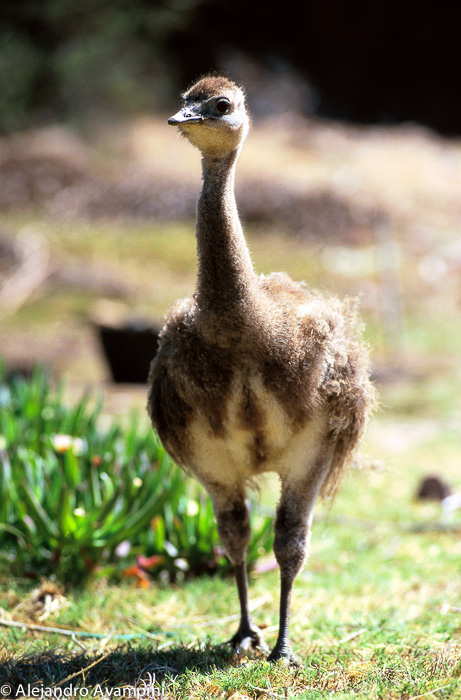
Leyend of the Mocovies tribe and the southern cross
“The old chief recalled that his father had told him that Manic, the rhea, was the animal with the most beautiful feathers. The chief sent for the best hunter in the tribe: Nemec, an agile and faithful youth. The boy looked his best weapons. He has never seen a rhea – this mysterious bird was unknown in the hinterland. Nemec asked the elders of the tribe to give him advice. He was told that Manic was very fast and it was impossible to find him without his noticing. He had to find a footprint similar to a bird, but much larger, and that the key was to follow the South path. Grateful Nemec left with the honour and responsibility of such a goal. He walked for days until one afternoon, when he found tracks: they were heading south, and he followed them. Walking under the first light of the next day, he noticed something strange. He looked up and there it was. It was the rhea, with its long, slender legs, with its beautiful plumage shaken by the wind, trembling his little head supported by a long neck, and looking at who knows what… But what struck him most were his feathers and he knew why the chief wanted to have them. Nemec remembered his duty. He crept. He almost threw the spear when the rhea escaped at full speed, leaving just an astonished hunter. The next day, Nemec followed the tracks and again found his target. But the rhea escaped again. The same thing happened again and again. Nemec began to doubt if he really would get to hunt it. Then he found it at sunset. There it was, and the opportunity could not be wasted. Man and animal froze. Suddenly, Nemec ran with all his might. The rhea ran also. Nemec flexed his arm and released the weapon. And, according to Mocovi legend, Manic spread his wings and soared. And continued rising until he reach the sky, and in the dim light of dusk, was lost to view. Suddenly, in the same place where the rhea had disappeared, four stars emerged in a cross: one took Choique’s chick or “charito”. the place of the head; two marked the tips of its wings and the last, the end of its legs.Nemec spent the night watching the sky and recalling images of the rhea he could never catch. The next day, he started back to his home. He arrived back at the tribe with empty hands but with a twinkle in his eye. That night, when everyone sat around the campfire, Nemec told of his strange adventure. Then, they saw the new stars that the sky was wearing, indicating forever the direction in which Manic had escaped: south.”
Variable Hawk
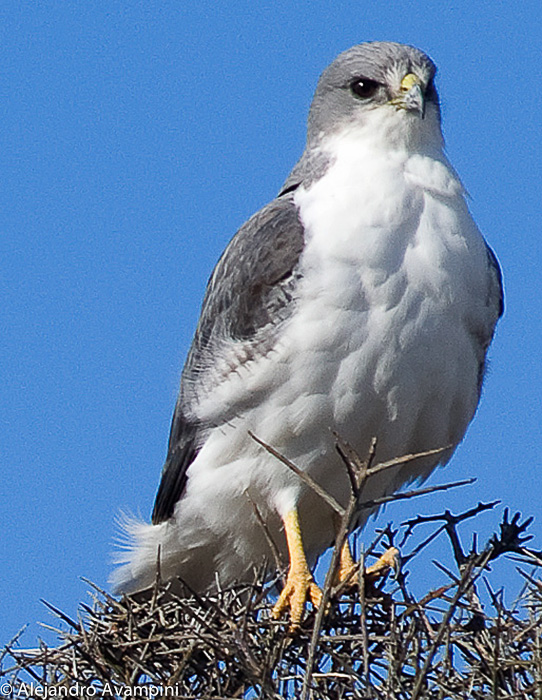
Also known as “Ñanco”, it can be seen throughout the Valdes Peninsula. The males measure up to 48 cm and the female is slightly larger, reaching 52 cm. The plumage is grey on the back, with a white underside in adults. Its’ most distinctive feature is a black stripe down the tail. Juveniles keep their brownish striped and spotted plumage and yellow legs for two years. It feeds on small mammals, nothing bigger than the hare and also varying species of birds. Some reptiles, amphibians and invertebrates are also included in the diet. The method of hunting is to fly in a circular motion over an area and plunge at an angle, striking the prey on the back with it’s powerful talons.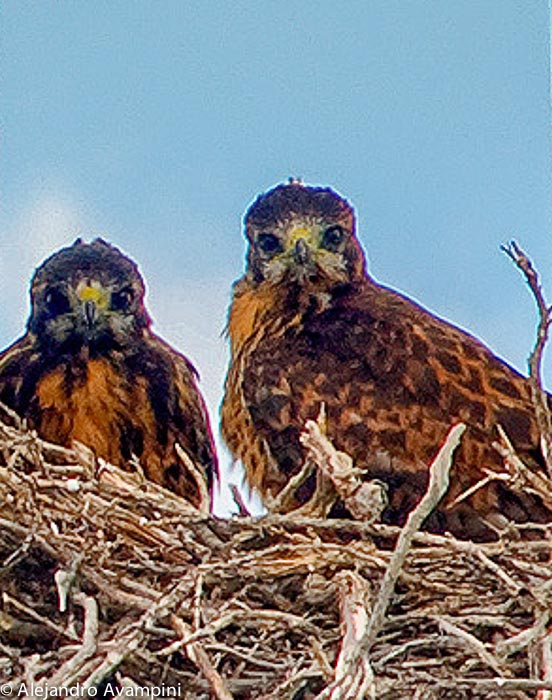
Nests are built by both members of the pair. The Variable Hawk likes thorny trees, in this region, preferring to nest in Molles The bird will also nest lamp posts. The nest is large, about three feet in diameter and is made of sticks. The male feeds the female during incubation. After the chicks hatch (in December), she will be responsible for them. Folk tales say that if, when travelling, a hawk crosses your path in front of you, your trip will go well. If, however, it crosses your path behind you, you should take great care until you reach your destination.
Black Chested Buzzard Eagle
 The Black Chested Buzzard Eagle (Geranoaetus Melanoleucus) is a fast hunter that occupies most of the South American Continent from Venezuela to The land of Fire and the Beagle Channel. This is a diurnal bird that occupies, in relatively small numbers, the Valdes Peninsula.
The Black Chested Buzzard Eagle (Geranoaetus Melanoleucus) is a fast hunter that occupies most of the South American Continent from Venezuela to The land of Fire and the Beagle Channel. This is a diurnal bird that occupies, in relatively small numbers, the Valdes Peninsula.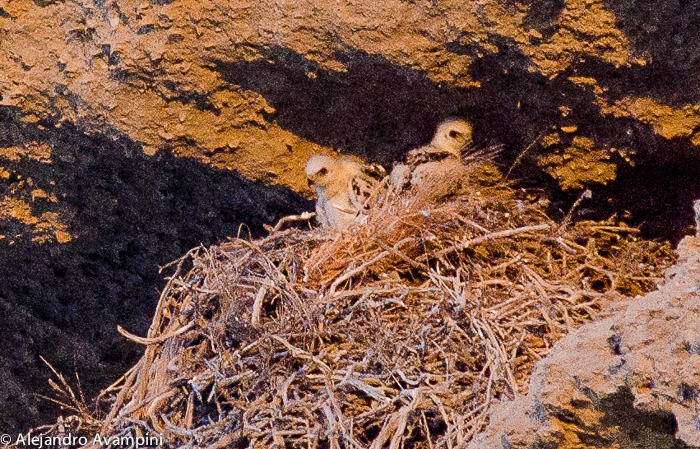 Their nests are found on outcroppings of cliffs with extremely difficult access and their nests are large platforms of sticks and branches. A female will lay 2 eggs in October and the chicks will hatch around the end of November beginning of December. By February the chicks are large enough and have enough experience to leave the nest.
Their nests are found on outcroppings of cliffs with extremely difficult access and their nests are large platforms of sticks and branches. A female will lay 2 eggs in October and the chicks will hatch around the end of November beginning of December. By February the chicks are large enough and have enough experience to leave the nest.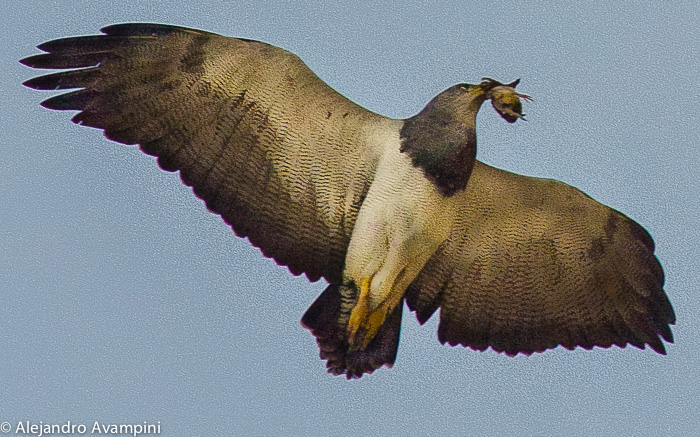 A large part of their diet is made up of rodents and small mammals, though they do also hunt and eat other small birds, as seen in the above image. On this occasion I observed it carrying its prey to the nest to feed the anxiously awaiting chicks. This banquet ensures continued growth, maintaining a species that enriches our planets biodiversity.
A large part of their diet is made up of rodents and small mammals, though they do also hunt and eat other small birds, as seen in the above image. On this occasion I observed it carrying its prey to the nest to feed the anxiously awaiting chicks. This banquet ensures continued growth, maintaining a species that enriches our planets biodiversity.
Great Egret
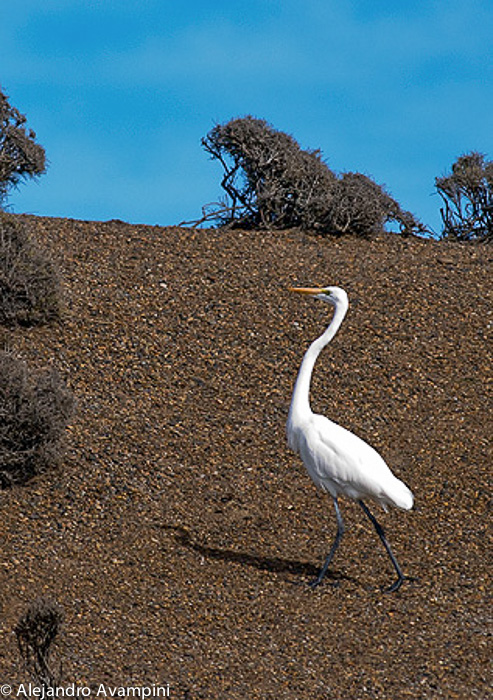
This long legged Patagonian Resident is also seen regularly in the Valdes Peninsula. Teetering on the edge of extinction in the early 1900s due to women’s fashion, this elegant bird has survived and although still somewhat scarce, each year can be observed in greater numbers. They were killed for the male’s long dorsal feathers used in the birds courting behavior.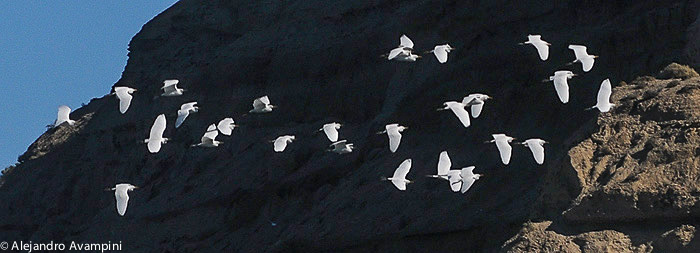 These feathers were used in hairstyles and hats and were acquired at a high price, creating an uncontrolled extermination with no respect for the bird’s reproduction. The creation and application of legislation together with changing styles helped reverse the situation. During reproductive season they will nest together in colonies as large as 20 individuals.
These feathers were used in hairstyles and hats and were acquired at a high price, creating an uncontrolled extermination with no respect for the bird’s reproduction. The creation and application of legislation together with changing styles helped reverse the situation. During reproductive season they will nest together in colonies as large as 20 individuals.
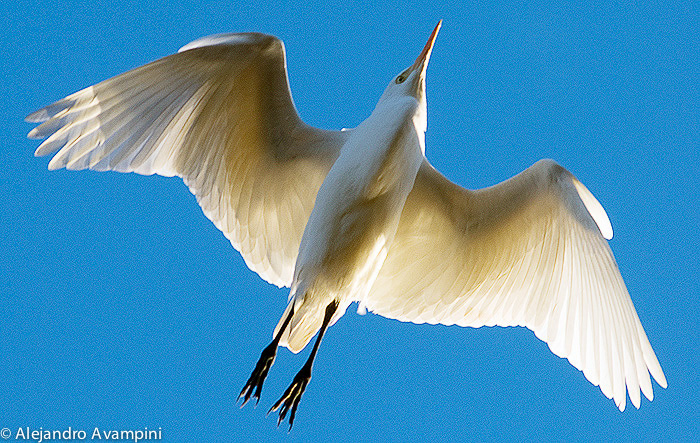 This species is easily recognized in flight due to its long legs stretched out in back and its long neck pulled inward in an “S” shape and the perfect form it takes while majestically gliding through the air.
This species is easily recognized in flight due to its long legs stretched out in back and its long neck pulled inward in an “S” shape and the perfect form it takes while majestically gliding through the air.
Reproduction
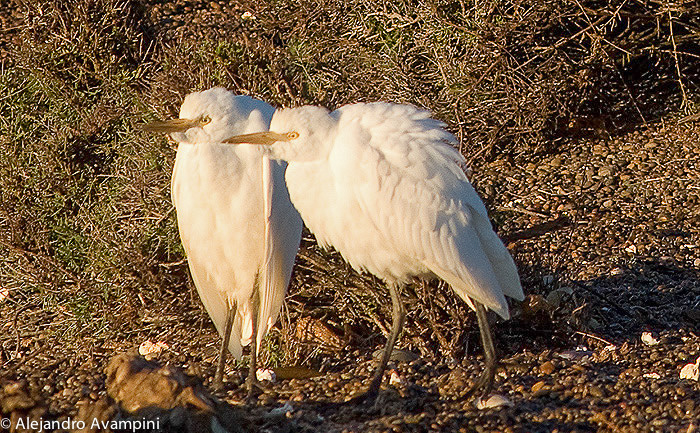 For the building of their nest a pair of Great Egrets will look for an area with trees and easy access to large quantities of dead branches, willows, grasses or dry leaves. Together with these materials they will construct a large platform in which six to eight light-blue eggs will be laid.
For the building of their nest a pair of Great Egrets will look for an area with trees and easy access to large quantities of dead branches, willows, grasses or dry leaves. Together with these materials they will construct a large platform in which six to eight light-blue eggs will be laid.
Turkey Vulture
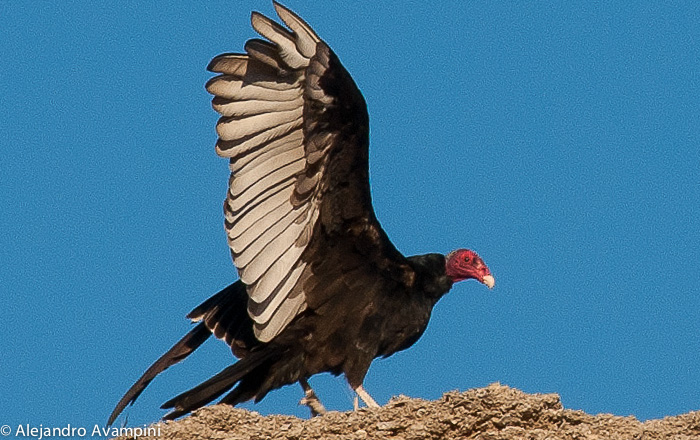 The turkey vulture is a bird of the vulture family , which can be found all across the Americas. In the different countries of the continent, it has different names, such as buzzard, aura, or just vulture. In Valdes Peninsula, it is one of the largest of the vultures, with a red head, blackish plumage, more brown on the upper surface of the wings. The underside of the flight feathers are grey, creating a sharp contrast. The head is small in proportion to the body and has no feathers – in adults it is reddish and in juveniles, it is black.
The turkey vulture is a bird of the vulture family , which can be found all across the Americas. In the different countries of the continent, it has different names, such as buzzard, aura, or just vulture. In Valdes Peninsula, it is one of the largest of the vultures, with a red head, blackish plumage, more brown on the upper surface of the wings. The underside of the flight feathers are grey, creating a sharp contrast. The head is small in proportion to the body and has no feathers – in adults it is reddish and in juveniles, it is black.  It weighs between 1.4 and 2.7 kg, measures 60-76 cm in length and has a wingspan of up to 2 meters. It glides with wings in a “V” shape and often sways in a way that gives the impression that it is drunk. It’s typically seen in Puerto Piramides, flying around the valley, and taking advantage of thermal wind generated by the hills that protect the town from east to west, on the north side. The turkey vulture is a scavenger, ranging over large distances and finding carrion with a keen sense of smell. Typically, it will feed on the carcasses of sea lions, guanaco, hares and rabbits. If it finds a large piece of carrion, such as a calf, it will circle over it, to let other vultures know where the carcass is.
It weighs between 1.4 and 2.7 kg, measures 60-76 cm in length and has a wingspan of up to 2 meters. It glides with wings in a “V” shape and often sways in a way that gives the impression that it is drunk. It’s typically seen in Puerto Piramides, flying around the valley, and taking advantage of thermal wind generated by the hills that protect the town from east to west, on the north side. The turkey vulture is a scavenger, ranging over large distances and finding carrion with a keen sense of smell. Typically, it will feed on the carcasses of sea lions, guanaco, hares and rabbits. If it finds a large piece of carrion, such as a calf, it will circle over it, to let other vultures know where the carcass is.
Burrowing Parrot
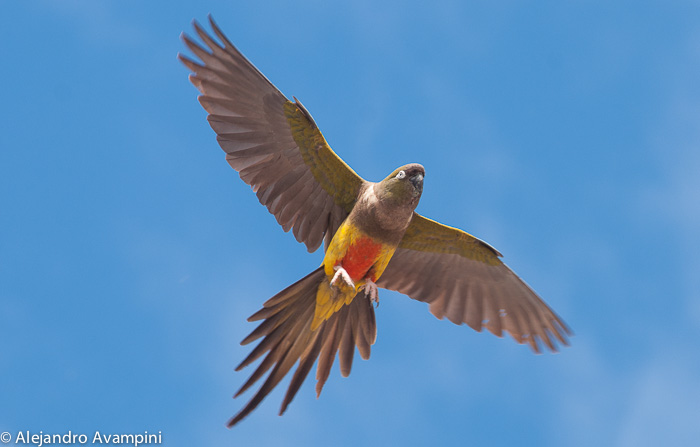 They are usually seen on Valdes Peninsula during spring and summer months. It mates for life and nests in cliffs. They dig a deep burrow in which 2 to 5 eggs are laid. The eggs hatch in late December. The Burrowing Parrot is very colourful and has seven colours in its plumage. On Valdes Peninsula, they are usually seen in flocks of 10- 20 individuals and are very noisy, constantly chattering. Their diet is based on shoots and fruits of shrubs, and they also travel great distances to feed in other regions, attracted by planted fields. This frequently leads to conflict with farmers, because they eat the seed and damage crops. We would to recommend a unique place for travellers, birdwatchers and those who are attracted by birds and nature. 550 km north of Valdes Peninsula, there is a town called El Condor, the Viedma’s beach, capital of Rio Negro province.There is one of the largest parrot colonies in the world, comprising over 100,000 Burrowing Parrots in 9 km of cliff, something which cannot be seen anywhere else on the Planet. We were surprised when we saw this incredible cliff, another natural wonder of Patagonia Argentina, which we had never heard of before. If you decide to go spend a few nights at this resort we recommend the Apart Hotel Costa del Faro, located on the coast, just meters from the cliff.
They are usually seen on Valdes Peninsula during spring and summer months. It mates for life and nests in cliffs. They dig a deep burrow in which 2 to 5 eggs are laid. The eggs hatch in late December. The Burrowing Parrot is very colourful and has seven colours in its plumage. On Valdes Peninsula, they are usually seen in flocks of 10- 20 individuals and are very noisy, constantly chattering. Their diet is based on shoots and fruits of shrubs, and they also travel great distances to feed in other regions, attracted by planted fields. This frequently leads to conflict with farmers, because they eat the seed and damage crops. We would to recommend a unique place for travellers, birdwatchers and those who are attracted by birds and nature. 550 km north of Valdes Peninsula, there is a town called El Condor, the Viedma’s beach, capital of Rio Negro province.There is one of the largest parrot colonies in the world, comprising over 100,000 Burrowing Parrots in 9 km of cliff, something which cannot be seen anywhere else on the Planet. We were surprised when we saw this incredible cliff, another natural wonder of Patagonia Argentina, which we had never heard of before. If you decide to go spend a few nights at this resort we recommend the Apart Hotel Costa del Faro, located on the coast, just meters from the cliff.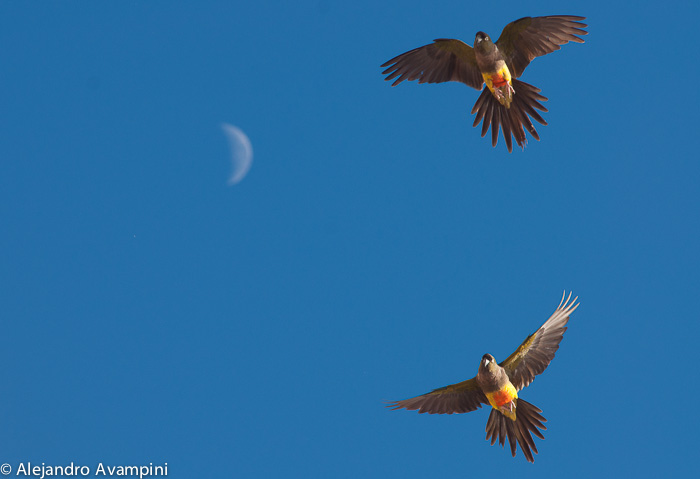
Long-tailed meadowlark

The long-tailed meadowlark (Sturnella loyca), lives in open places in Valdes Peninsula. In spring and summer breeding season, they live in pairs nest in the ground and the female lays 3 to 4 eggs. Here in Puerto Piramides, usually they perch on bushes behind the dunes of Del Nomade Eco – Hotel. They feed on fruit, insects and seeds, these birds will consider it a good omen.
Red Knot
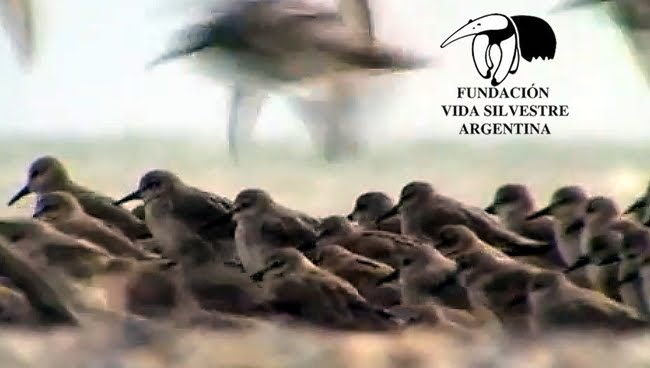 Along their amazing migratory route of unimaginable proportions which begins in the Northern Autumn in the Canadian Arctic and takes them to the Southern extremes, only to then be repeated 4 months later as they return north with their offspring, the Red Knot (Calidris Canutus) and other migratory birds deviate from a straight line to “re-fuel” at 2 specific beaches of the Valdes Peninsula, fundamental for their survival. In their return journey north, a feeding stop is made at the Fracasso and Colombo beaches. The attached video, produced by the Wild-Life Foundation (Fundacion Vida Silvestre), describes the special characteristics found at these two places and explains why they do not stop on the way South. Also illustrated in this documentary is the important roll these humid, marine-coastal zones of the Valdes Peninsula play is sustaining the population of certain species of migratory birds.
Along their amazing migratory route of unimaginable proportions which begins in the Northern Autumn in the Canadian Arctic and takes them to the Southern extremes, only to then be repeated 4 months later as they return north with their offspring, the Red Knot (Calidris Canutus) and other migratory birds deviate from a straight line to “re-fuel” at 2 specific beaches of the Valdes Peninsula, fundamental for their survival. In their return journey north, a feeding stop is made at the Fracasso and Colombo beaches. The attached video, produced by the Wild-Life Foundation (Fundacion Vida Silvestre), describes the special characteristics found at these two places and explains why they do not stop on the way South. Also illustrated in this documentary is the important roll these humid, marine-coastal zones of the Valdes Peninsula play is sustaining the population of certain species of migratory birds.
Great Grebe
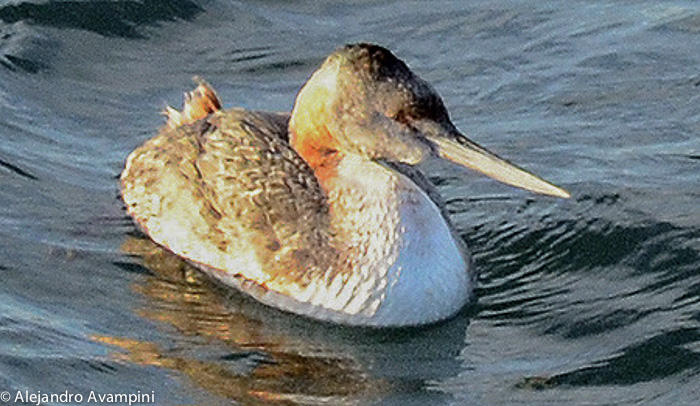 The Great Grebe (Podicephorus major) is coastal bird that is frequently seen in the Valdes Peninsula. Rarely seen in groups or on dry land, they are generally found swimming in shallow water close to the shore, alone or as a pair. The plumage is primarily rust colored around the neck with a black head and white chest. Resident to Patagonia this is not a migratory bird and can be observed fishing or hunting crabs along the shallow waters of both the Golfo Nuevo and Golfo San Jose.
The Great Grebe (Podicephorus major) is coastal bird that is frequently seen in the Valdes Peninsula. Rarely seen in groups or on dry land, they are generally found swimming in shallow water close to the shore, alone or as a pair. The plumage is primarily rust colored around the neck with a black head and white chest. Resident to Patagonia this is not a migratory bird and can be observed fishing or hunting crabs along the shallow waters of both the Golfo Nuevo and Golfo San Jose.
Southern Giant Petrel
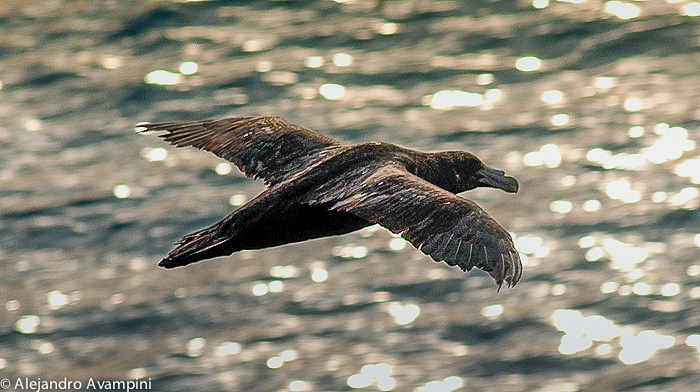 This special bird has an incredibly aerodynamic shape. The distance between the tips of the extended wings reaches 2m. An adult male can weigh up to 5 kg. The family feature is the nostril, located in the upper beak in the form of a single nasal tube, but internally divided in two by a central partition. Monitoring these birds has shown that they have incredible flying skills and stamina.
This special bird has an incredibly aerodynamic shape. The distance between the tips of the extended wings reaches 2m. An adult male can weigh up to 5 kg. The family feature is the nostril, located in the upper beak in the form of a single nasal tube, but internally divided in two by a central partition. Monitoring these birds has shown that they have incredible flying skills and stamina.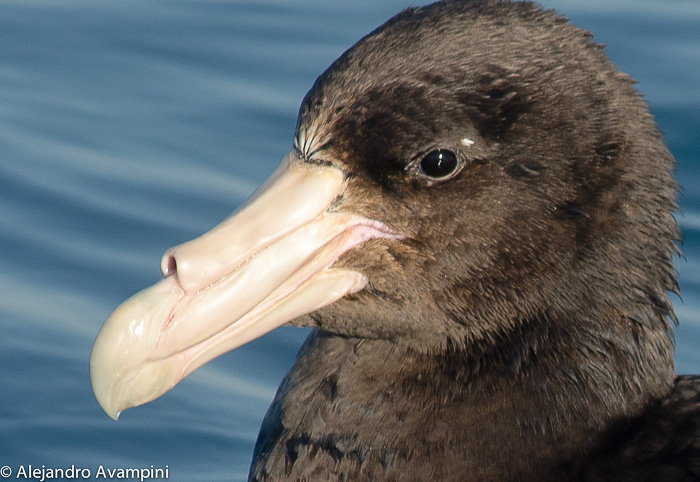
Feeding
They have an excellent sense of smell which helps them find food on the coast. It does not only feed on carrion, such as dead penguins, sea lions and elephant seals, it will also eat penguin or other birds chicks, eggs and sometimes hunts penguins and other seabirds as prey. In the sea they feed on refuse dumped by hundreds of fishing boats which jettison fish unwanted for human consumption, that is to say that tons of dead fish daily discarded at sea. Human predation is causing birds like Giant Petrel have more food as a result of which, their lifespan and reproducion rate are increasing. Consequently birds currently appear in disproportionate numbers, compared to previous years. 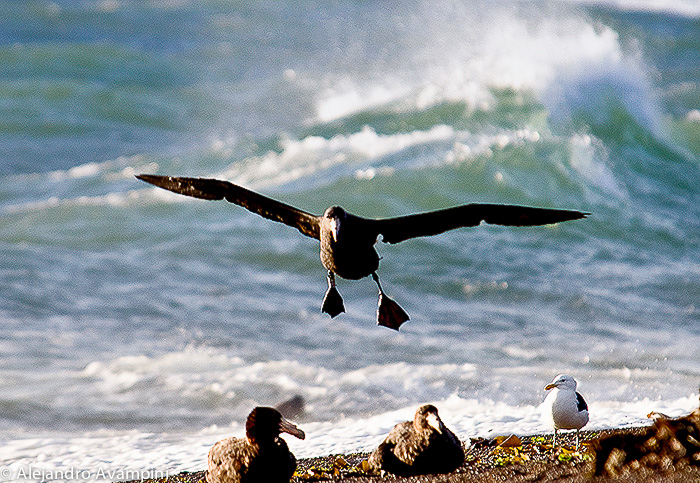
Reproduction
In the colonies of northern Patagonia, the laying date (for a single egg) begins during the last week of October and is relatively synchronous. The first chicks hatch during the last week of December. Adults remain in the nest with the chick for nearly two weeks, after which time, the chicks are left alone in the colony while parents feed at sea, returning to regurgitate food for them. In Patagonia, the chicks become independent around the second week of March and early April. En consecuencia son aves que en la actualidad se ve en número desproporcionado a años anteriores. El monitoreo de ejemplares demostró que vuelan distancias increibles.Un ejemplar anillado en Nueva Zelanda se vió una semana después en las costas patagónicas, lo que implica que volaron mas de 5000 km en menos de 7 días, sobre el agua!!!
Burrowing Owl
The Latin name of this species “cunicularia” means “digging mines or tunnels”, reflecting how this owl builds its nest: in underground tunnels. The owl typically nests in open areas, under the protection of a tree or shrub. It chooses sloping ground, which prevents rainwater from entering the tunnel and flooding it. It is not averse to making use of the abandoned nesting tunnels of other birds and animals.
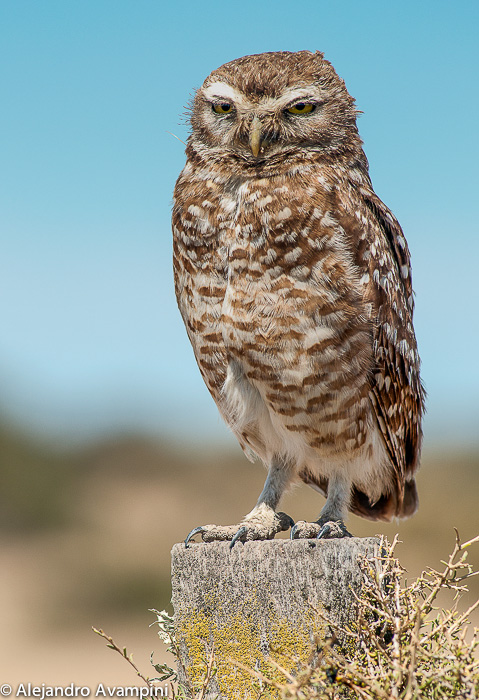
The Burrowing Owl commonly excavates a burrow at the side of fields or by roadsides. Should the entrance become blocked for whatever reason, it will excavate another burrow at the edge of the field. The nesting season runs from October to December. The chicks hatch in 28 days. During hot spells, they can be seen rubbing their beaks or cuddling each other. The owl is not afraid man, on the contrary, it easily adapts to his presence. It lives in open grasslands and can be found in the Caleta Valdes and Punta Delgada. Feeding Burrowing Owls have been subject to persecution by Man, due to irrational superstitions. As a result of this, in addition to placing the Burrowing Owl in danger of extinction, this persecution has altered the environmental balance. This is because, as well as birds, scorpions, insects and other small mammals, which, if allowed to multiply unchecked, would have an adverse effect upon agriculture, they eat rodents which are known carriers of Haemorrhagic Fever, or O’Higgins Disease, which is endemic in Argentina.Many times the man usually irrationality attacks the owls especially because superstitions. The Burrowing Owl has a refined sense of hearing. They can hear sounds of low intensity that allow them to detect the presence of small prey. The thick layer of feathers covering its flat face, operates as a kind of receiver screen that helps to focus sounds on the ears. Their natural predators are ferrets, weasels, cats and foxes, besides man. Whilst out and about, you are sure to see Burrowing Owls and, through binoculars, you will be able to see the deep and direct gaze of their large eyes. The owl’s eyes, like ours are front facing, resulting in binocular vision which allows refined perception of distance. The eyes have many photosensitive cells and large pupils, which permit the bird to distinguish objects clearly in low light.
Southern Martin
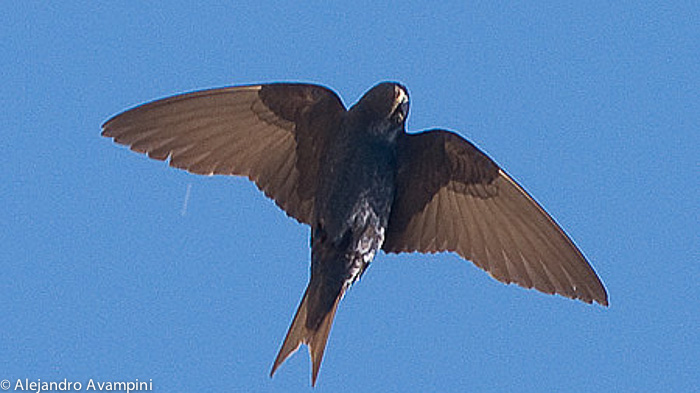
Southern Martin (Progne modesta) is a migratory bird that reaches the Valdes Peninsula in spring accompanied by its enjoyable song and normally observed in groups. This species can be observed in many areas throughout the American Continent with a migratory route that extends over thousands of kilometers. It is a bird that calls little attention to itself being small and relatively uniform in color it is often “lost” amongst the many other small birds, but to the trained eye this incredible and unique species will announce its arrival to Puerto Piramides in spring. The migratory route of this species whether coming or going from the reproductive zone or its wintering area can comprise a distance of as much as 12,000 kilometers. Those of the Valdes Peninsula, in general, migrate to Peru at a rate of some 200km per day. They feed almost exclusively on insects and feed during daylight hours.
Carbonated Sierra-Finch
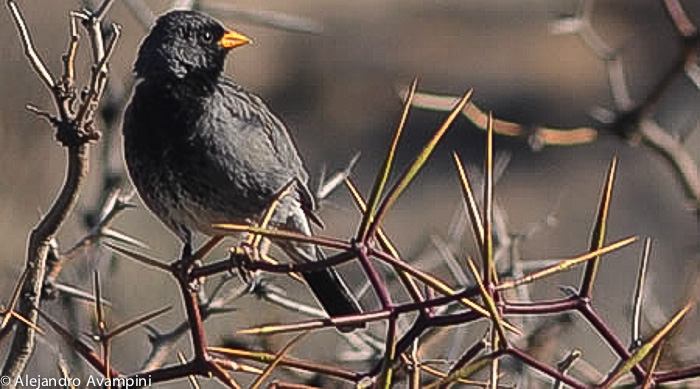
The Carbonated Sierra-Finch (Phrygilus carbonarius), to the untrained eye, is easily confused with a House Sparrow or Rufous-collared Sparrow. During courting behavior the male’s plumage will darken, differentiating it from the female. With their nest close by, we have observed a darker male in the sand dunes behind Del Nomade, flying from bush to bush with its mate. This tiny bird can be found throughout the Peninsula and easily observed in Punta Norte, if quiet, it is curious and not easily frightened.
Yellow-billed Pintail
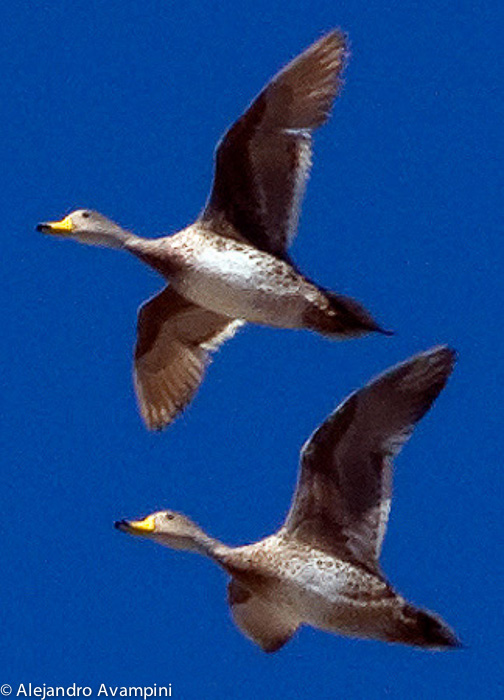
The Yellow-billed Pintail (Anas georgica) is a bird of South America. Lives from southern Brazil to southern Patagonia. He looks in freshwater lakes and occasionally frequents marine coast. It has a significant extent in terms of habitat preference. They can be seen on the sea coast of Patagonia or greater heights of 4,000 m. These birds nest near water and bowl-shaped nests are shallow and sheathes of down. Flocks can be found in the lakes that form after heavy rains.
Shoveler
The Shoveler (Anas platalea) you can see it in Valdes Peninsula. While lives from Tierra del Fuego to the Mesopotamian region (Entre Rios and Corrientes) is not easy to find in this area. It is found in fresh or brackish water and can be seen occasionally on the sea coast.

The male has a particularly clear eye, not the female. It is valued by ornithologists bird, as are all the birds that visit the Natural Paradise Valdes Peninsula.

Common Oyster Catcher
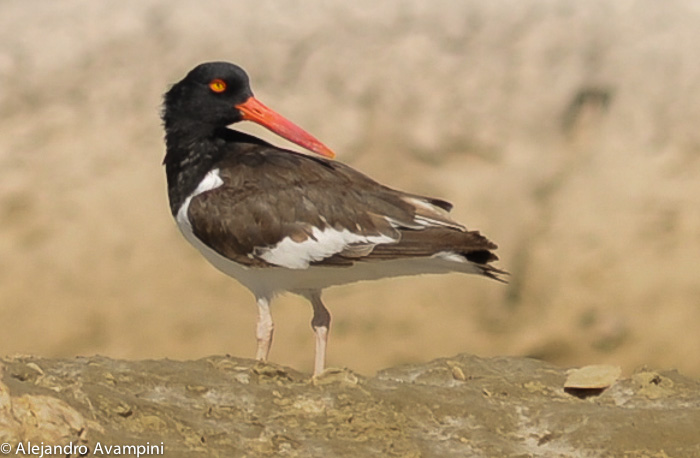 The Common Oyster Catcher (Haemantopus palliatus) is a bird that basks in the solitude of the Patagonian Coast living in a life-long mating pair, these birds are bothered by human presence. With a dark brown back, yellow eye and bright red ocular ring and a long red beak, they can reach a size of more than 40cm. and 700gr. They will build a camouflaged nest just meters from the high tide line.
The Common Oyster Catcher (Haemantopus palliatus) is a bird that basks in the solitude of the Patagonian Coast living in a life-long mating pair, these birds are bothered by human presence. With a dark brown back, yellow eye and bright red ocular ring and a long red beak, they can reach a size of more than 40cm. and 700gr. They will build a camouflaged nest just meters from the high tide line.
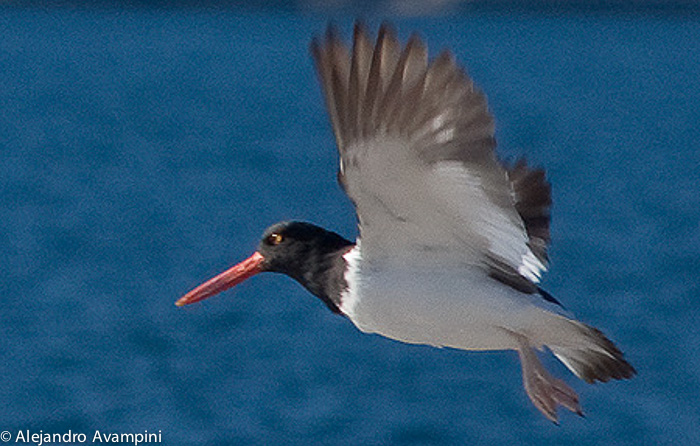 The wings of the Oyster Catcher are dark brown on top but while in flight the plumage below their wings is White. A guaranteed sighting of this species will be found walking towards the caves, a 2,5km coastal walk from Puerto Piramides. When approaching, these birds will begin with their unique sounds, alerting other birds in the area.
The wings of the Oyster Catcher are dark brown on top but while in flight the plumage below their wings is White. A guaranteed sighting of this species will be found walking towards the caves, a 2,5km coastal walk from Puerto Piramides. When approaching, these birds will begin with their unique sounds, alerting other birds in the area.
South American Tern
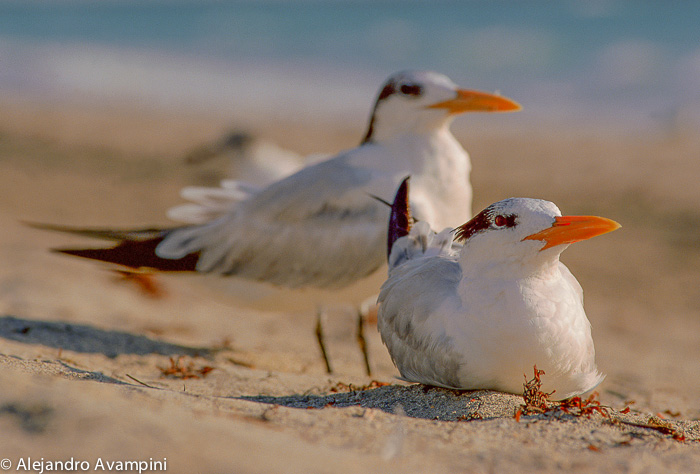 The South American Tern is one of the 3 species of terns that nest on the coast of Argentina and is found inValdes Peninsula. It is rather more difficult to observe that the kelp gull, because it has a small population size. The breeding season begins in December and you will be able to see them flying over the ledges and cliffs. After nesting, from March onwards they are no longer predictable. Terns nest every year, but not in the same places, often choosing quiet coastal places in very exposed sites but are very sensitive to disturbance. Their diet is based on fish; their fishing technique is to plunge into the sea s to capture their prey.
The South American Tern is one of the 3 species of terns that nest on the coast of Argentina and is found inValdes Peninsula. It is rather more difficult to observe that the kelp gull, because it has a small population size. The breeding season begins in December and you will be able to see them flying over the ledges and cliffs. After nesting, from March onwards they are no longer predictable. Terns nest every year, but not in the same places, often choosing quiet coastal places in very exposed sites but are very sensitive to disturbance. Their diet is based on fish; their fishing technique is to plunge into the sea s to capture their prey.
Imperial Cormorant
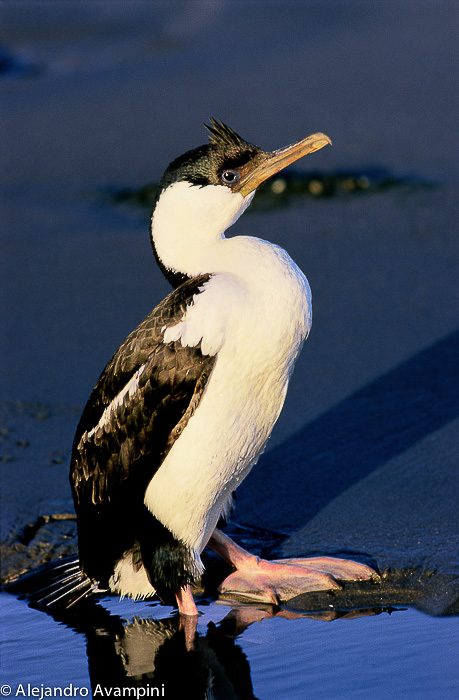
Along the entire coast of continental Patagonia, the imperial cormorant is a species almost piscivorous but also feeds on marine invertebrates such as cephalopods, crustaceans and polychaetes. The Imperial Cormorant consumes a large proportion of pelagic and demersal fishes such as anchovy, hake and some species of mackerel and uses a broad range of depths throughout the water column.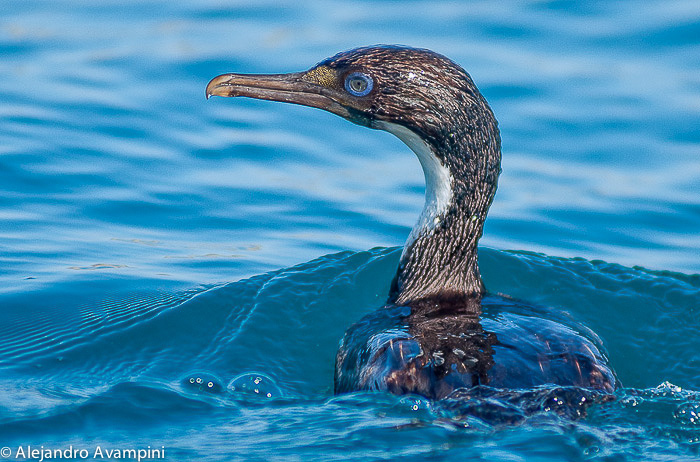 Recent studies showed that the Imperial Cormorant feeds both in shallow coastal waters as well as deep waters (about 70m) and offshore (more than 8 km). The imperial cormorant is the leading producer of guano in Patagonia. Currently, the guano is mined in only a few colonies of Chubut and Santa Cruz. The guano exploitation is still carried out in a similar way to that of a few decades ago, and its extraction is carried out manually and sporadically.
Recent studies showed that the Imperial Cormorant feeds both in shallow coastal waters as well as deep waters (about 70m) and offshore (more than 8 km). The imperial cormorant is the leading producer of guano in Patagonia. Currently, the guano is mined in only a few colonies of Chubut and Santa Cruz. The guano exploitation is still carried out in a similar way to that of a few decades ago, and its extraction is carried out manually and sporadically.
Rock Cormorants
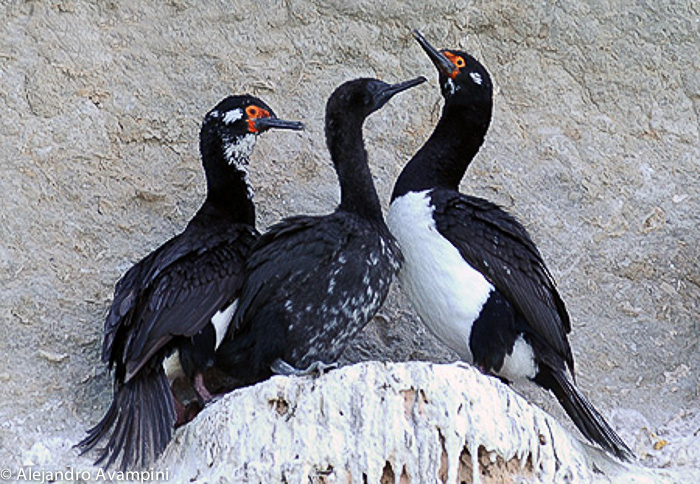 Rock Cormorants (Phalacrocorax magellanicus) are maritime birds that rook on rocky cliffs, and thus their name. They are extremely well adapted birds both in flight and below the water. Underwater they advanced using their webbed feet. This species exists only in the Patagonian region of Argentina and Chile. The Rock Cormorant colony at Punta Loma in one of the largest, with approximately 280 mating pairs and other, smaller rookeries exist along the coast of Golfo Nuevo. They will remain in the same colony throughout the year while adapting their behavior in accordance to the changing seasons. From March through September they are primarily found feeding and spend very little time on the nest. From October through February their behavior changes dramatically as they dedicate most of their time to mating, incubating and raising their chicks. The chicks will hatch 30 days after the female lays her eggs, usually just 2 eggs that will be mutually incubated by the pair. For two months the pair will take turns protecting the nest and chicks while the other heads out to sea in search of food.
Rock Cormorants (Phalacrocorax magellanicus) are maritime birds that rook on rocky cliffs, and thus their name. They are extremely well adapted birds both in flight and below the water. Underwater they advanced using their webbed feet. This species exists only in the Patagonian region of Argentina and Chile. The Rock Cormorant colony at Punta Loma in one of the largest, with approximately 280 mating pairs and other, smaller rookeries exist along the coast of Golfo Nuevo. They will remain in the same colony throughout the year while adapting their behavior in accordance to the changing seasons. From March through September they are primarily found feeding and spend very little time on the nest. From October through February their behavior changes dramatically as they dedicate most of their time to mating, incubating and raising their chicks. The chicks will hatch 30 days after the female lays her eggs, usually just 2 eggs that will be mutually incubated by the pair. For two months the pair will take turns protecting the nest and chicks while the other heads out to sea in search of food. 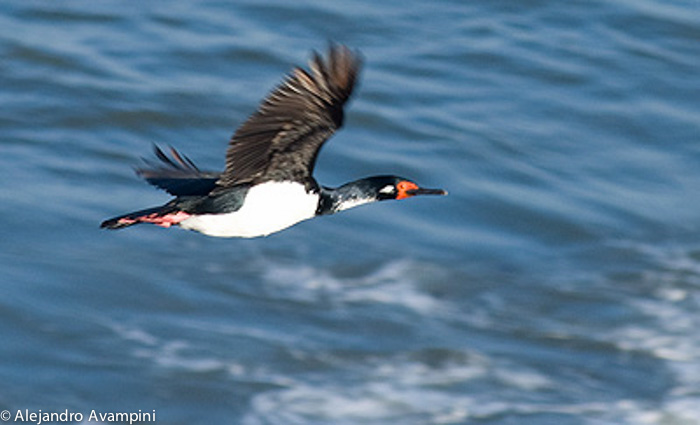 These Cormorants are frequently observed flying a precise straight line just above the surface of the ocean and, from time to time, lightly touching the surface with the tip of their wings. This species almost exclusively feeds on fish and in contrast to other cormorants, observations suggest that it mostly feeds on species of schooling fish. In a maritime environment the Neo-Tropic Cormorant (Phalacrocorax olivaceus) has be observed feeding alone as well as in groups and almost exclusively in shallow coastal waters less than 1.3km from the shore and in no more than 10mt depth. After diving, they are commonly observed standing with their wings spread out in order to dry. Their nests are built with twigs cemented together with their own guano.
These Cormorants are frequently observed flying a precise straight line just above the surface of the ocean and, from time to time, lightly touching the surface with the tip of their wings. This species almost exclusively feeds on fish and in contrast to other cormorants, observations suggest that it mostly feeds on species of schooling fish. In a maritime environment the Neo-Tropic Cormorant (Phalacrocorax olivaceus) has be observed feeding alone as well as in groups and almost exclusively in shallow coastal waters less than 1.3km from the shore and in no more than 10mt depth. After diving, they are commonly observed standing with their wings spread out in order to dry. Their nests are built with twigs cemented together with their own guano.
Neotropic cormorant

It is frequently seen flying swiftly the Neotropic cormorant (Phalacrocorax olivaceus), almost touching the water with a straight and accurate flight; and occasionally they touch the surface with the wingtips. This species is basically piscivorous. However, the same observations suggest that, unlike the cormorant black neck and imperial cormorant , the diet of this species consists of a high proportion of fish that move in schools and near the surface such as mackerel and bottom fish like sea bass. In marine environments, it has been observed feeding both individually and in flocks. primarily (under 1.3 km and no more than 10 m deep) It feeds in coastal waters and shallow. After his dives in search of food, it is commonly seen with outspread wings toward the sun on some safe pathways to get rid of moisture. They build nests with branches cemented his own guano.
Brown Hooded Gull
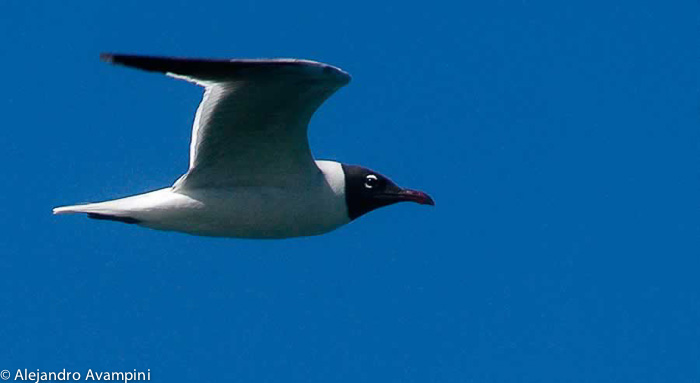
The Brown Hooded Gull (Larus maculipennis) gets its name for an obvious reason. Standing at approximately 35cm this bird has a distinct dark-brown head, combined with white and grey plumage over the rest of its body and dark plumage on the tips of its wings and tail feathers. Its beak, feet and legs are red. According to the Coastal Patagonia Bird and Mammal guide, written by Guillermo Harris, the Brown Hooded Gull can be found year round thourghout the Valdes Peninsula. Courting and mating behavior begins in October, the chicks will hatch in November and will abandon their nest in February. They are easily observed along the coast of Puerto Madryn and El Doradillo.
Seagull
It is the most abundant species on our coastline, with a huge population and many subspecies. It is considered one of the most important components in the dynamics of many towns on the Patagonian coast.  It can measure up to 60 centimeters in length, the body is white and the wings black. Gulls are present all over Patagonia, extending to Tierra del Fuego and beyond, as far south as the Falkland Islands, South Atlantic Islands and Antarctica. They lay up to three eggs, nest and return to the same area every year. They feed naturally on intertidal resources, although their behaviour is very opportunistic and has been modified by the food supply generated by humans. Because of this, the growth of populations of gulls has grown-up considerably. They feed in open dumps, eat carrion, insects, grains, small fishes and …whales! The behaviour of gulls feeding off whales is, we believe, unique to our region.
It can measure up to 60 centimeters in length, the body is white and the wings black. Gulls are present all over Patagonia, extending to Tierra del Fuego and beyond, as far south as the Falkland Islands, South Atlantic Islands and Antarctica. They lay up to three eggs, nest and return to the same area every year. They feed naturally on intertidal resources, although their behaviour is very opportunistic and has been modified by the food supply generated by humans. Because of this, the growth of populations of gulls has grown-up considerably. They feed in open dumps, eat carrion, insects, grains, small fishes and …whales! The behaviour of gulls feeding off whales is, we believe, unique to our region.
Attacks to whales
 In the last decade whales have been affected by attacks by gulls, who have developed a liking for the proteins in the skin and blubber of whales. Over the years, the technique that had developed by only a few gulls, has been passed on to other birds and new generations, making the attacks happen more frequently and altering the behaviour of these giant cetaceans. Moreover, fish discards and waste dumps, and mainly the landfill at Puerto Madryn, have led to a huge increase in the numbers of seagulls, which have food guaranteed all year, thus increasing their birth rate. As a result, the number of individuals is grows-ing exponentially in Valdes Peninsula.
In the last decade whales have been affected by attacks by gulls, who have developed a liking for the proteins in the skin and blubber of whales. Over the years, the technique that had developed by only a few gulls, has been passed on to other birds and new generations, making the attacks happen more frequently and altering the behaviour of these giant cetaceans. Moreover, fish discards and waste dumps, and mainly the landfill at Puerto Madryn, have led to a huge increase in the numbers of seagulls, which have food guaranteed all year, thus increasing their birth rate. As a result, the number of individuals is grows-ing exponentially in Valdes Peninsula. In order to escape the unwelcome and possibly painful attention of the gulls, whales have taken to adopting the “galleon” position, in which only the animal’s head and tail are exposed above water, the rest of the body being submerged. The also try to outwit the gulls by remaining submerged totally for longer periods, swimming and breaching. These techniques involve the whales expending a great deal more energy and, as the Valdes Peninsula is primarily a mating and breeding area, where food is not common, could have an adverse effect on the population.
In order to escape the unwelcome and possibly painful attention of the gulls, whales have taken to adopting the “galleon” position, in which only the animal’s head and tail are exposed above water, the rest of the body being submerged. The also try to outwit the gulls by remaining submerged totally for longer periods, swimming and breaching. These techniques involve the whales expending a great deal more energy and, as the Valdes Peninsula is primarily a mating and breeding area, where food is not common, could have an adverse effect on the population.
Case Study
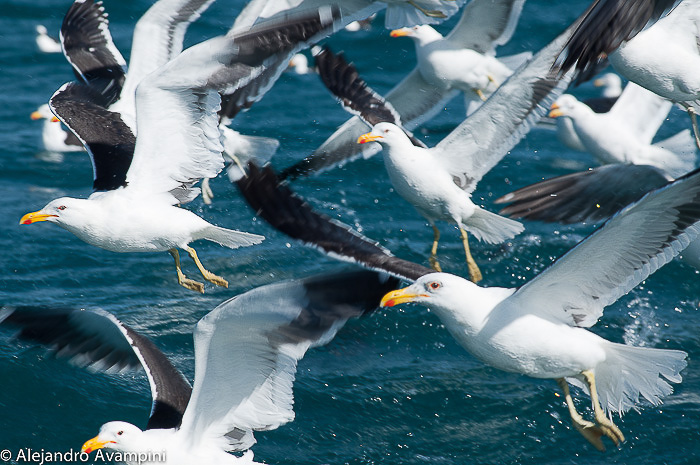 In 2005, a study group led by Ms. Anne Fazio, Biological Sciences graduate, and Dr. Marcelo Bertellotti, planned a study with three years’ duration, in which the first thing they wanted to know was, if the whales skin and fat feeding behaviour was or was not widespread throughout the population of gulls. They wanted to ring them, so as to identify them when they were attacking. This task took place at Punta Piramides platform, where there is a nesting colony of gulls. They captured the gulls by means of a cannon- net. The gulls were then ringed with individually coded rings and samples of blood and feathers etc were taken, to ascertain the overall health of the gull population. Despite the great effort and hours of work of the whole group, it became increasingly difficult to capture gulls, because they learned very fast and avoid the traps. In the event, ringing was achieved only in 20% of the population. In addition there are seagulls from different areas feeding on whales. Ana says that “(…) for these two reasons, the brand was very dilute, we had only 2% of cases where we saw a branded seagull attacking. Also, with so many hours and days of observation in the water, you could see that even not all the seagulls attacked, it was not a small group, and the worst of all: they were more and more!.
In 2005, a study group led by Ms. Anne Fazio, Biological Sciences graduate, and Dr. Marcelo Bertellotti, planned a study with three years’ duration, in which the first thing they wanted to know was, if the whales skin and fat feeding behaviour was or was not widespread throughout the population of gulls. They wanted to ring them, so as to identify them when they were attacking. This task took place at Punta Piramides platform, where there is a nesting colony of gulls. They captured the gulls by means of a cannon- net. The gulls were then ringed with individually coded rings and samples of blood and feathers etc were taken, to ascertain the overall health of the gull population. Despite the great effort and hours of work of the whole group, it became increasingly difficult to capture gulls, because they learned very fast and avoid the traps. In the event, ringing was achieved only in 20% of the population. In addition there are seagulls from different areas feeding on whales. Ana says that “(…) for these two reasons, the brand was very dilute, we had only 2% of cases where we saw a branded seagull attacking. Also, with so many hours and days of observation in the water, you could see that even not all the seagulls attacked, it was not a small group, and the worst of all: they were more and more!.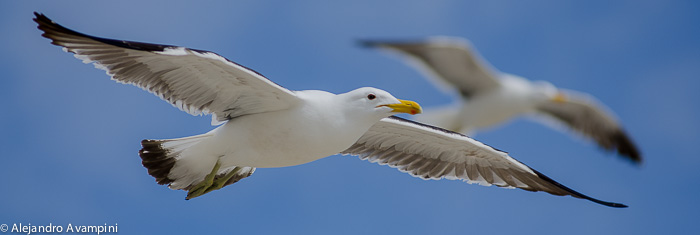 We also have an overall record of the attack rate during the three seasons of whales watching, knowing the peaks of the curves (times of increased number of attacks per unit time). This information is very useful, since at the time of taking up the study comparisons can be made with other years to see if the attack rate has increased or decreased. In addition, samples were analyzed to search for pathogens with which the gulls can infect whales; we’ve found some and it is something that really concerns us. It is likely that, by moving from whale to whale, the gulls will not only infect the whales with pathogens which they carry, but could also transmit as carriers, pathogens and infections which are carried by the whales. AsValdes Peninsula is an area with a high transient population of whales, including calves, this is a matter of real concern and could have a greater effect on the whales than a mere change in behaviour. “ One of the most important conclusions, agreed by a majority, was to close the open dump in Puerto Madryn. We know that populations of gulls increased for many years, until ‘97 and then remained constant. The main causes were fishing discards and waste dumps. That’s why the plan launched by the Province to eradicate open dumps around Chubut is an incrediblebreakthrough on minimizing environmental impact, and may the get the rate of reproduction of the gulls back into balance.
We also have an overall record of the attack rate during the three seasons of whales watching, knowing the peaks of the curves (times of increased number of attacks per unit time). This information is very useful, since at the time of taking up the study comparisons can be made with other years to see if the attack rate has increased or decreased. In addition, samples were analyzed to search for pathogens with which the gulls can infect whales; we’ve found some and it is something that really concerns us. It is likely that, by moving from whale to whale, the gulls will not only infect the whales with pathogens which they carry, but could also transmit as carriers, pathogens and infections which are carried by the whales. AsValdes Peninsula is an area with a high transient population of whales, including calves, this is a matter of real concern and could have a greater effect on the whales than a mere change in behaviour. “ One of the most important conclusions, agreed by a majority, was to close the open dump in Puerto Madryn. We know that populations of gulls increased for many years, until ‘97 and then remained constant. The main causes were fishing discards and waste dumps. That’s why the plan launched by the Province to eradicate open dumps around Chubut is an incrediblebreakthrough on minimizing environmental impact, and may the get the rate of reproduction of the gulls back into balance.




